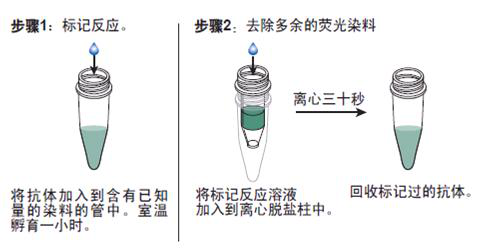
|

| 产地 | 进口、国产 |
| 品牌 | 上海莼试 |
| 保存条件 | Store at -20 °C |
| 货号 | CS11229 |
| 应用范围 | WB=1:100-500 ELISA=1:500-1000 IP=1:20-100 IHC-P=1:100-500 IHC-F=1:100-500 IF=1:100-500 |
| CAS编号 | |
| 抗体名 | Anti-RANK/CD265 |
| 克隆性 | |
| 靶点 | 详见说明书 |
| 适应物种 | 详见说明书 |
| 形态 | 详见说明书 |
| 宿主 | 详见说明书 |
| 亚型 | IgG |
| 标识物 | 详见说明书 |
| 浓度 | 1mg/1ml% |
| 免疫原 | KLH conjugated synthetic peptide derived from human RANK C-terminus |
产品订购信息:
英文名称 Anti-RANK/CD265
中文名称 核转录因子NF-κB受体抗体(核因子kB受体活化因子)费用
别 名 TNFRSF11A; CD265; CD265 antigen; Activator of NFKB; EOF; FEO; mRANK; NFKB activator; ODFR; OFE; Osteoclast differentiation factor receptor; PDB 2; Receptor activator of NF KB; receptor activator of nuclear factor kappa B; TNFRSF 11A; TNFSF11; TRANCE R; RANK receptor.


浓 度 1mg/1ml
规 格 0.1ml/100μg 0.2ml/200μg
抗体来源 Rabbit
克隆类型 polyclonal
交叉反应 Human, Mouse, Rat
产品类型 一抗
研究领域 细胞生物 转录调节因子 细胞表面分子
蛋白分子量 predicted molecular weight: 63-70kDa
性 状 Lyophilized or Liquid
免 疫 原 KLH conjugated synthetic peptide derived from human RANK C-terminus
亚 型 IgG
纯化方法 affinity purified by Protein A
储 存 液 0.01M PBS, pH 7.4 with 10 mg/ml BSA and 0.1% Sodium azide
核转录因子NF-κB受体抗体(核因子kB受体活化因子)费用 产品应用 WB=1:100-500 ELISA=1:500-1000 IP=1:20-100 IHC-P=1:100-500 IHC-F=1:100-500 IF=1:100-500
(石蜡切片需做抗原修复)
not yet tested in other applications.
optimal dilutions/concentrations should be determined by the end user.
保存条件 Store at -20 °C for one year. Avoid repeated freeze/thaw cycles. The lyophilized antibody is stable at room temperature for at least one month and for greater than a year when kept at -20°C. When reconstituted in sterile pH 7.4 0.01M PBS or diluent of antibody the antibody is stable for at least two weeks at 2-4 °C.
Important Note This product as supplied is intended for research use only, not for use in human, therapeutic or diagnostic applications.
产品介绍 CD265 is a member of the tumor necrosis factor receptor (TNFR) family. Human and murine CD265 share 81% amino acid identity in their extracellular domains. CD265 is widely expressed, with highest levels in skeletal muscle, thymus, liver, colon, small intestine and adrenal gland. CD265 is also expressed in dendritic cells. RANK and RANK ligand (RANKL) are important regulators of interactions between T cells and dendritic cells. RANK is the essential signaling receptor for osteoclast differentiation factor in osteoclastogenesis. Multiple tumor necrosis factor receptor-associated factors (TRAFs) are involved in the signaling of CD265. TRANCE (TNF-related activation-induced cytokines, also known as RANK ligand, osteoprotegerin ligand and osteoclast differentiation factor) is the ligand for CD265. The biological functions mediated by RANK include activation of NFkappaB and cjun N-terminal kinase, enhancement of T cell growth and dendritic cell function, induction of osteoclastogenesis and lymph node organogenesis. The soluble form of CD265 is able to block TRANCE induced biological activity. The binding of anti-CD265 to cell surface CD265 triggers signal transduction and induces CD265 mediated bioactivity.
Function : Receptor for TNFSF11/RANKL/TRANCE/OPGL; essential for RANKL-mediated osteoclastogenesis. Involved in the regulation of interactions between T-cells and dendritic cells.
Subcellular Location : Membrane.
Tissue Specificity : Ubiquitous expression with high levels in skeletal muscle, thymus, liver, colon, small intestine and adrenal gland.
DISEASE : Defects in TNFRSF11A are the cause of familial expansile osteolysis (FEO) [MIM:174810]. FEO is a rare autosomal dominant bone disorder characterized by focal areas of increased bone remodeling. The osteolytic lesions develop usually in the long bones during early adulthood. FEO is often associated with early onset deafness and loss of dentition.
Defects in TNFRSF11A are a cause of Paget disease of bone type 2 (PDB2) [MIM:602080]; also known as familial Paget disease of bone. PDB2 is a bone-remodeling disorder with clinical similarities to FEO. Unlike FEO, however, affected individuals have involvement of the axial skeleton with lesions in the spine, pelvis and skull.
Similarity : Contains 4 TNFR-Cys repeats.
核因子kB受体活化因子 RANK

Ki-67(Antigen identified by monoclonal antibody Ki 67) Ki-67 AntigenMulti-class antibodies规格: 0.5mg
Anti-phospho-Afadin(Ser1718) 磷酸化丝状肌动蛋白结合蛋白抗体Multi-class antibodies规格: 0.1ml
Rhesus antibody Rh Phospho-Caspase-9 (Thr125) 磷酸化半胱氨酸蛋白酶9抗体 规格 0.1ml
小鼠血清封闭液 10ml Gibco原料,2%血清
VEGF-D 英文名称: 内皮生长因子D型抗体 0.1ml
DNA polymerase eta 英文名称: DNA聚合酶η抗体 0.2ml
Anti-phospho-Afadin(Ser1718) 磷酸化丝状肌动蛋白结合蛋白抗体Multi-class antibodies规格: 0.1ml
Anti-pre-X protein(NT)/FITC 荧光素标记抗乙毒pre-X蛋白抗体(N端)IgGMulti-class antibodies规格: 0.2ml
Rabbit Anti-HRP Whole serum 兔抗HRP抗血清Multi-class antibodies规格: 1ml
白介素10抗体 Anti-IL-10 0.1ml
Donkey anti-Goat IgG whole serum 驴抗羊IgG抗血清 1ml
Phospho-FAK(Tyr576) 英文名称: 磷酸化粘着斑激酶抗体 0.1ml
Rhesus antibody Rh phospho-PTPN7(Ser246) 磷酸化非受体型蛋白酪氨酸磷酸酶7抗体 规格 0.1ml
Rabbit Anti-HRP Whole serum 兔抗HRP抗血清Multi-class antibodies规格: 1ml
SPAG17 英文名称: 相关抗原17抗体 0.2ml
eIF3H 英文名称: 真核翻译起始因子3H抗体 0.1ml
内皮生长因子受体2抗体 Anti-VEGFR2/VEGF-R2/Flk1 0.1ml
Anti-TSARG4/FITC 荧光素标记生精细胞凋亡相关基因4抗体IgGMulti-class antibodies规格: 0.2ml
Rhesus antibody Rh phospho-IKKi/IKKe(Thr500) 磷酸化核因子NFκB抑制蛋白激酶i抗体 规格 0.1ml
CAP2(Adenylyl cyclase-associated protein 2) 环化酶相关蛋白CAP-2抗原Multi-class antibodies规格: 0.5mg
MDA-MB-231(ATCC来源), 人癌细胞
Hacat 人永生化角质细胞
EPHA4 Others Human 人 EPHA4 人细胞裂解液 (阳性对照)
CM-R115大鼠小梁网细胞完全培养基100mL
周边细胞培养基PM
EB病毒转化的人B淋巴细胞;KMY0920 人皮肤肥大细胞完全培养基 100mL
CL-0050Caco-2(人结直肠腺癌细胞)5×106cells/瓶×2
FCGR3A Others Human 人 CD16a / FCGR3A CHO细胞裂解液 (阳性对照)
纤维粘连蛋白-牛源BPF
大额牛肾细胞;BFR-K1 细胞,SP2/0细胞 DU145(细胞)
EB病毒转化的人B淋巴细胞(彝族);HYL
JAG1 Others Human 人 JAG1 / JAGL1 / CD339 人细胞裂解液 (阳性对照)
核转录因子NF-κB受体抗体(核因子kB受体活化因子)费用 MDA-MB-231(ATCC来源), 人癌细胞
Hacat 人永生化角质细胞
EPHA4 Others Human 人 EPHA4 人细胞裂解液 (阳性对照)
CM-R115大鼠小梁网细胞完全培养基100mL
周边细胞培养基PM
EB病毒转化的人B淋巴细胞;KMY0920 人皮肤肥大细胞完全培养基 100mL

抗体的生物素化标记实验要点:
1. 核转录因子NF-κB受体抗体(核因子kB受体活化因子)费用 如在反应混合液中有叠氮钠或游离氨基存在,会抑制标记反应。因此,蛋白质在反应前要对 0.1mol/L碳酸氢钠缓冲液或0.5mol/L硼酸缓冲液充分透析;
2.所用的NHSB及待生物素化蛋白质之间的分子比按蛋白质表面的ε-氨基的密度会有所不同,选择不当则影响标记的效率,应先用几个不同的分子比来筛选最适条件;
3.用NHSB量过量也是不利的,抗原的结合位点可能因此被封闭,导致抗体失活;
4.由于抗体的氨基不易接近可能造成生物素化不足,此时可加入去污剂如 Triton x-100, Tween20等;
5.当游离ε-氨基(赖氨酸残基的氨基)存在于抗体的抗原结合位点时,或位于酶的催化位点时,生物素化会降低或损伤抗体蛋白的结合力或活性;
6.生物素还可能与不同的功能基团,如羰基、氨基、巯基、异咪唑基及苯酚基,也可与糖基共价结合;
7.交联反应后,应充分透析,否则,残余的生物素会对生物素化抗体与亲和素的结合产生竞争作用;
8.在细胞的荧光标记实验中,中和亲和素的本底低,但由于链霉亲和素含有少量正电荷,故对某些细胞可导致高本底。
抗体的鉴定:
1)核转录因子NF-κB受体抗体(核因子kB受体活化因子)费用 抗体的效价鉴定:不管是用于诊断还是用于,制备抗体的目的都是要求较高效价。不同的抗原制备的抗体,要求的效价不一。鉴定效价的方法很多,包括有试管凝集反应,琼脂扩散试验,酶联免疫吸附试验等。常用的抗原所制备的抗体一般都有约成的鉴定效价的方法,以资比较。如制备抗抗体的效价,一般就采用琼脂扩散试验来鉴定。
2)抗体的特异性鉴定:抗体的特异性是指与相应抗原或近似抗原物质的识别能力。抗体的特异性高,它的识别能力就强。衡量特异性通常以交叉反应率来表示。交叉反应率可用竞争抑制试验测定。以不同浓度抗原和近似抗原分别做竞争抑制曲线,计算各自的结合率,求出各自在IC50时的浓度,并按公式计算交叉反应率。
如果所用抗原浓度IC50浓度为pg/管,而一些近似抗原物质的IC50浓度几乎是无穷大时,表示这一抗血清与其他抗原物质的交叉反应率近似为0,即该血清的特异性较好。
3)抗体亲和力:是指抗体和抗原结合的牢固程度。亲和力的高低是由抗原分子的大小,抗体分子的结合位点与抗原决定簇之间立体构型的合适度决定的。有助于维持抗原抗体复合物稳定的分子间力有氢键,疏水键,侧链相反电荷基因的库仑力,范德华力和空间斥力。亲和力常以亲和常数K表示,K的单位是L/mol。抗体亲和力的测定对抗体的筛选,确定抗体的用途,验证抗体的均一性等均有重要意义。